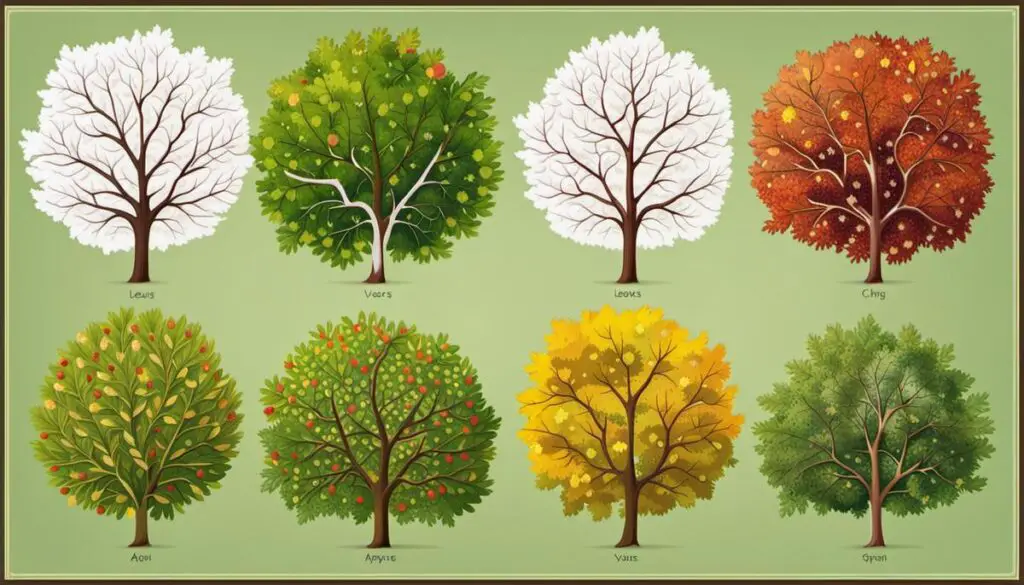Apple trees not only offer the reward of crisp, delicious fruits but also attribute to the charm of a backyard or a landscape with their lush green foliage. Nevertheless, when the radiant green of apple tree leaves begin to transform into an alarming yellow, it becomes cause for concern. In our quest to comprehend this phenomenon, we highlight the typical lifecycle of apple tree leaves, taking you through each stage of their growth and the color changes they undergo with each season. Furthermore, we delve into the crucial area of nutrient deficiencies, their impact on apple trees, and how to diagnose them. We also undertake a detailed discourse on the diseases and pests that infect apple trees, along with potential treatments. In addition, we discuss the environmental stressors that cause yellowing of leaves and suggest preventive measures and methods of rectification. Lastly, we underline effective and commonly practiced methods to maintain apple tree health.
Understanding the normal lifecycle of apple tree leaves
Normal Lifecycle of Apple Tree Leaves
An apple tree goes through a cycle every year, marked by changes in the color and vibrancy of its foliage. It begins in early spring when the tree comes back to life after winter dormancy. The apple tree sprouts bright green, new leaves that are full of vitality. As the tree begins to bloom with flowers, this is also the time when the growth of the leaves is most vigorous.
To support the growing fruit, the leaves continue to increase in vibrancy through late spring and early summer. They serve as a crucial component in photosynthesis, the process that allows the tree to produce food for growth and apple production. Due to the chlorophyll present within them, the leaves maintain their lush green color, which is a sign of a healthy apple tree.
As summer transitions into fall, the arrival of cooler temperatures and shorter days trigger a change in the apple tree. The chlorophyll breaks down, revealing the underlying colors in the leaves. As a result, apple tree foliage turns into hues of yellow, orange, and red, creating a beautiful autumn display. Once winter arrives, the apple tree enters a state of dormancy, losing its leaves in preparation for the colder months. The cycle then starts again with the sprouting of new leaves in the subsequent spring.
Recognizing Unexpected Yellowing in Apple Tree Leaves
If you notice the leaves on your apple tree turning yellow during unusual times in its lifecycle, it could be a signal of a potential problem. There are several possible reasons for this change in leaf color:
Nutrient Deficiency: One of the more frequent causes of yellowing leaves is a nutrient deficiency, usually Nitrogen. While apple trees aren’t particularly finicky about soil fertility, they do need a balanced supply of Nitrogen, Phosphorus, and Potassium, along with other minor nutrients.
Inaccurate Watering: An incorrect watering routine can also result in yellow leaves. Saturating the tree excessively can lead to a waterlogged and oxygen-deprived root system. Conversely, while apple trees can endure some drought conditions, prolonged dryness can result in dehydration and stress, leading to yellow leaves.
Pest or Disease Attacks: Unfortunately, various pests and diseases can afflict apple trees, many of which may result in unnatural yellowing and premature leaf shedding. Potential issues include apple scab, powdery mildew, and several types of root rot.
In all of these situations, it’s crucial to identify and address the problem as quickly as possible. Prompt action can salvage the health and fruit-bearing capacity of your apple tree. Recognizing the standard lifecycle of apple tree leaves is key to this process, as it provides a benchmark to detect any abnormalities.
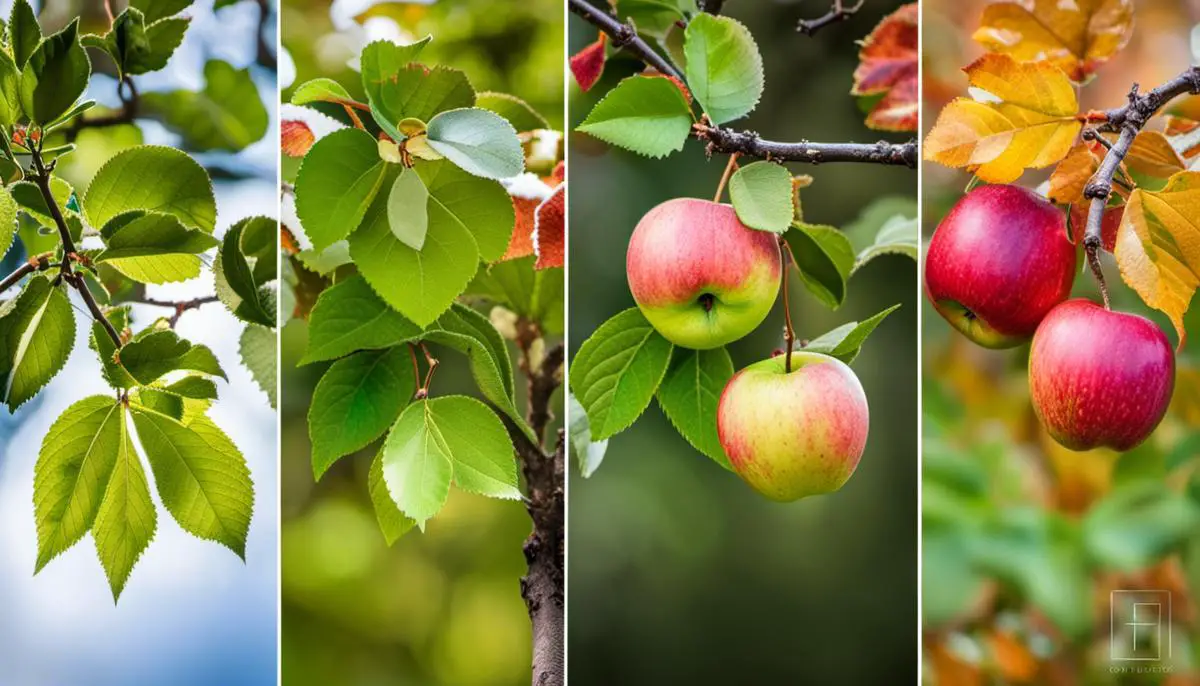
Key signs of nutrient deficiencies in apple trees
Decoding the Yellowing of Apple Tree Leaves: Nutrient Deficiencies
Observing yellow leaves on your apple tree may signify a lack of vital nutrients. Such nutrients are indispensable for the overall well-being of the tree. If deficient, the leaves can start to discolor to yellow and may eventually fall off, negatively impacting the tree’s capacity to conduct photosynthesis and propagate healthy apples.
Key Nutrients for Apple Trees
Apple trees require numerous nutrients to maintain their health and productivity. These include Nitrogen (N), Phosphorus (P), Potassium (K), Calcium (Ca), and Magnesium (Mg). Zinc (Zn) and Iron (Fe) are also important, albeit required in smaller amounts.
Nitrogen
Nitrogen, the primary nutrient responsible for leaf growth and color, is crucial. Nitrogen deficiency can lead to yellowed leaves, especially in the lower branches. Over time, these leaves may develop reddish or purplish hues and become curled or scorched.
Phosphorus
Phosphorus stimulates root development and promotes fruit maturity. A deficiency may slow the tree’s growth and cause leaves to darken and drop prematurely.
Potassium
Potassium boosts disease resistance and helps regulate water within the tree. A potassium-starved apple tree may display yellowing leaf tips, which may eventually curl and brown.
Calcium
Calcium is essential for cell growth in all parts of an apple tree. Insufficient calcium may result in yellowing leaves with curled edges.
Magnesium
Magnesium contributes to photosynthesis, and lack thereof can cause leaf yellowing, starting with older lower leaves and spreading upward.
Zinc and Iron
Zinc and iron deficiencies may lead to yellowing between the leaf veins, a condition known as interveinal chlorosis.
Diagnosing Nutrient Deficiencies
Determining if yellowing apple tree leaves are due to a nutrient deficiency involves several steps. Visual cues are the first indicator. However, symptoms of different nutrient deficiencies can overlap, making diagnosis challenging.
Soil testing is a more precise way to determine nutrient deficiency. Collect soil from around the tree to a depth of 6 to 12 inches, and send the sample to a testing lab or use a home soil test kit.
Addressing Nutrient Deficiencies
When apple trees lack certain essential nutrients, their leaves can start turning yellow. Thankfully, these nutrient deficiencies can be adjusted with the application of an appropriate fertilizer at the right time. If your apple tree has a nitrogen deficiency, a nitrogen-rich fertilizer can help. Fertilizers containing phosphorus and potassium are suitable for supplementing phosphorus and potassium deficiencies. Additionally, calcium shortage may be addressed with lime, while a deficiency of magnesium can be corrected using Epsom salts.
For addressing deficiencies of zinc and iron, foliar applications – spraying these nutrients directly onto tree leaves – are most effective as they are absorbed faster. It is crucial to always follow the instructions on the label when applying any nutrient remedies to ensure proper usage.
Finally, bear in mind that a balanced soil pH is key to optimal nutrient absorption for your apple tree. An ideal pH range for apple trees is slightly acidic, between 6.0 and 7.0.
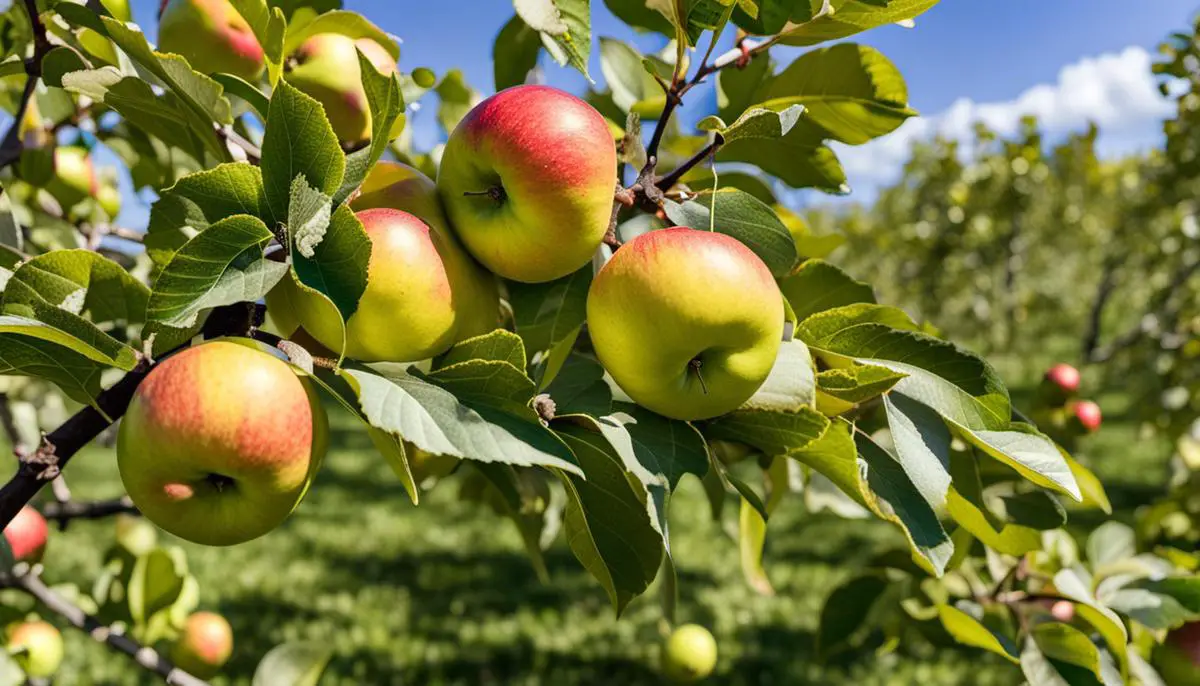
Impact of disease and pests on apple tree leaves
Aside from nutrient deficiencies, there are other possible culprits for yellowing leaves on apple trees. These trees can be vulnerable to various diseases and pests, all of which can lead to yellowing leaves, affecting not only the health and lifespan of the trees but also their aesthetics and productivity. Therefore, taking a holistic approach to tree care is important, to ensure your apple trees stay as healthy as possible.
Apple Tree Diseases Resulting in Yellow Leaves
Several diseases can cause apple tree leaves to yellow. Fire blight is a bacterial disease that initially causes wilting and blackening of blossoms and a watery ooze on branches. As it progresses, this disease can cause leaves to yellow and curl.
Another condition, known as apple scab, is caused by a fungus that produces dark, scaly lesions on leaves, fruit, and twigs. In the fall, leaves may yellow and drop prematurely as a reaction to the disease.
Cedar-apple rust, another fungal disease, produces bright orange-yellow spots on leaves and can cause yellowing and premature leaf drop if severe.
Pests That Can Cause Yellowing of Apple Tree Leaves
Pests can also cause apple tree leaves to turn yellow. Aphids are small insects that can infest apple trees, sucking the sap from the leaves and causing them to become yellow and curled. Apple tree borers are a type of beetle that lay their eggs in the bark of apple trees, and when the larvae hatch, they burrow into the tree, which can cause the leaves to wilt and turn yellow.
Approaches to Management and Treatment
Preventing diseases is one of the most effective methods in controlling them. Use disease-resistant apple tree varieties and maintain good hygiene by removing and disposing of fallen fruits and leaves. Also, ensure regular pruning of your trees.
Several fungicides are available to control diseases. For instance, copper-based sprays are effective against fire blight, while sulfur or mancozeb-containing fungicides handle apple scab proficiently.
When it comes to pests, beneficial creatures such as ladybugs and lacewings can be useful. They prey on problematic pests like aphids. Regular inspections of your apple trees can help detect pests early, and treat them using suitable insecticides.
In the scenario of an infestation, it’s generally more practical to seek professional assistance for accurate diagnosis and treatment. Even so, familiarizing oneself with typical apple tree diseases and pests that might cause yellowing of leaves can help maintain the health and productivity of the trees.
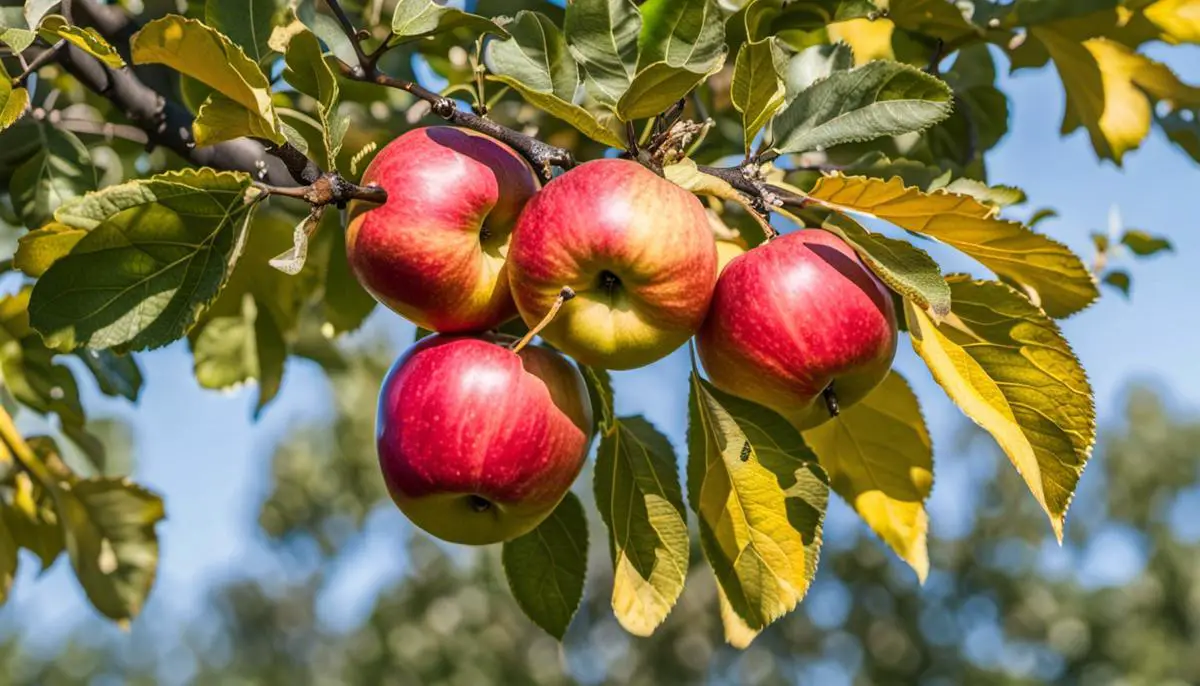
Environmental stressors causing yellow leaves
Impacts of Environmental Stressors on Yellow Leaves
Yellow leaves on apple trees, otherwise known as chlorosis, could be a result of several environmental stressors. Potential causes are inadequate watering circumstances, excessive heat, lack of sunlight, soil compaction, and lack of essential nutrients. Recognizing the specific cause is crucial in implementing the correct counter-measures.
Poor Watering Conditions
Inconsistent watering can lead to yellowing of apple tree leaves. Both over watering and under watering can stress the trees. Over watering may cause root rot, which impedes the tree’s uptake of necessary nutrients, leaving its foliage yellowed and wilted. Meanwhile, under watering leads to dehydration, which could result in the tree dropping leaves prematurely.
Excessive Heat Stress
Exposed to excessive heat, apple trees undergo stress, which may also lead to leaf yellowing. Prolonged periods of high temperatures can cause the trees to lose moisture faster than they can absorb it. This may lead to scorching and ultimately, yellowing of leaves. Providing adequate shade and watering could help the apple tree cope with heat stress.
Inadequate Sunlight
Apple trees need full sunlight for optimal growth. Inadequate sunlight could hinder photosynthesis and cause leaves to turn yellow. If a tree is shaded by buildings or other trees, it may become necessary to trim or remove the blocking objects if possible, or consider relocating the apple tree to a sunnier spot.
Soil Compaction
Compact soils negatively affect the tree’s root health, resulting in poor nutrient and water absorption leading to yellowing of leaves. If soil compaction is detected, the soil should be aerated to allow for better water and nutrient penetration.
Nutrient Deficiency
Nutrient deficiency, particularly of nitrogen, can cause apple tree leaves to yellow. Fertilizing the tree with a fertilizer specifically designed for fruit trees can correct this. It’s crucial to follow the manufacturer’s instructions regarding the amount and frequency of application. A soil test can also provide detailed information about nutrient levels in the soil.
Disease and Pest Infestation
Yellowing leaves on apple trees can also point towards disease or pest infestation issues. These may include apple scab, fire blight, powdery mildew, and various kinds of pests, such as apple aphids and apple maggots. Regular monitoring, pruning, and the use of appropriate pesticides can prevent such infestations.
It is essential to grasp that identifying the underlying cause and addressing the issue promptly is pivotal in preserving the overall vitality of your apple trees and averting the yellowing of the leaves.
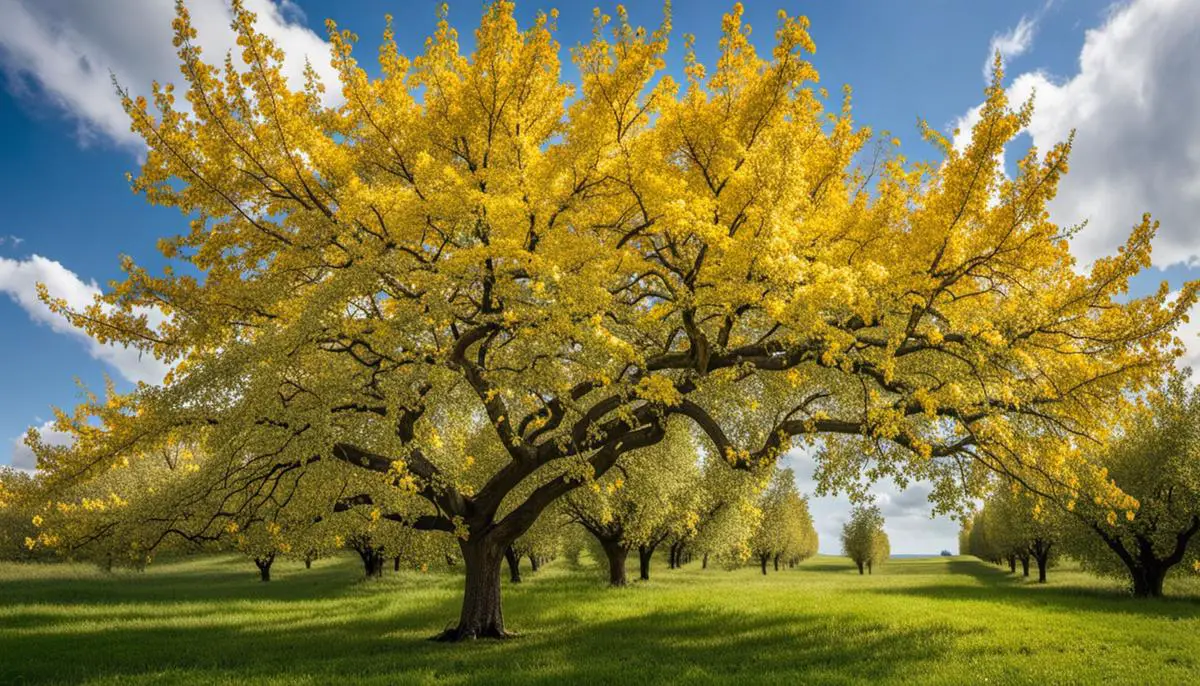
Best care practices to maintain healthy apple tree leaves
Recommended Watering Practices for Apple Trees
Consistent watering is paramount for apple trees to sustain a resilient and lush leaf color. Insufficient water could cause the tree to become dehydrated, leading to yellowing leaves that may eventually fall off. The advice is to water apple trees deeply, yet not too frequently, rather than little and often, enabling the water to access the deep root system and guaranteeing the tree receives the necessary moisture. As a general guideline, apple trees should be provided with approximately one inch of water per week, received from rain or additional irrigation.
Soil Preferences for Apple Trees
Apple trees prefer a well-drained soil that is rich in organic matter. Soil pH levels between 6.0 and 7.0 are ideal. If your soil is on the acidic side, you can add some lime to bring the pH level up. Conversely, if the soil is more alkaline, adding some sulphur can help bring the pH down to a more acceptable level for your apple trees. A nutrient-rich soil helps ensures the apple tree has the necessary nutrients to grow healthy leaves and prevent yellowing.
Pruning Methods for Apple Trees
Prune your apple tree regularly to promote healthy growth and airflow through the branches. By thinning out a dense canopy, sunlight can reach all the leaves, which aids in photosynthesis. This process helps the tree remain healthy and prevents yellowing leaves. Pruning old, dead, or diseased branches also stops potential disease spread, keeping the apple tree and its leaves healthy. It’s usually best to prune in late winter when the tree is dormant.
Additional Tips
Remember to do a pest and disease check on your apple tree regularly. Yellowing leaves can be an indication of an infestation or disease. Aphids, for instance, suck on the tree’s sap and cause the leaves to yellow and curl. Similarly, diseases like cedar-apple rust or Apple Scab can cause discoloration in leaves. If any such symptoms appear, consider investing in a pest control solution or fungicide spray, based on the problem diagnosed. Additionally, spacing your apple trees properly during planting ensures they have the necessary space to grow and allows better airflow, which aids in disease prevention.
Finally, mulching around the base of the apple trees can help retain soil moisture, control weeds, and maintain a steady soil temperature. This practice can indirectly help in maintaining the health of the tree and preventing leaf yellowing.
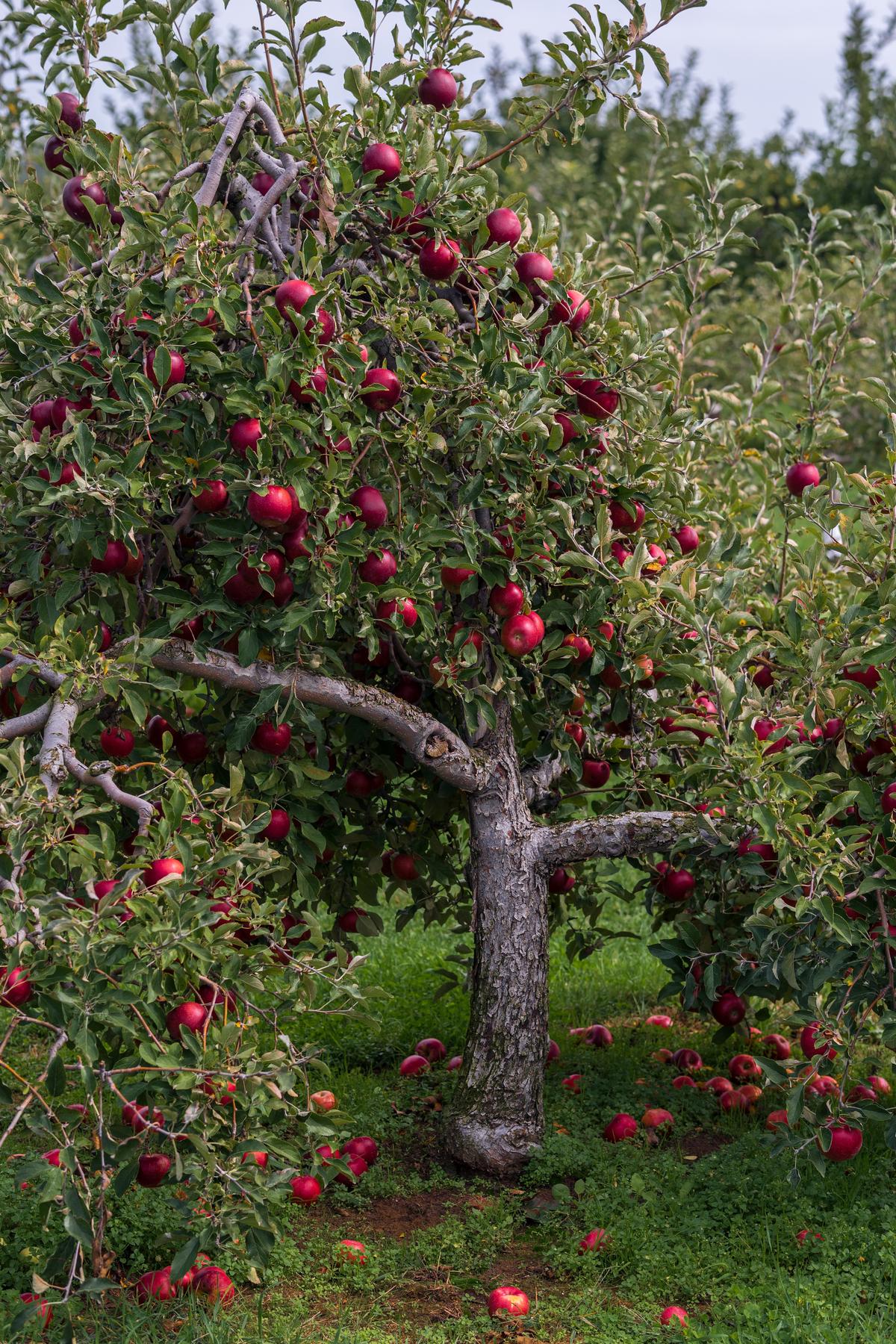
Having gained insights into the elements that could cause apple tree leaves to turn yellow, and the potential ways to address this issue, it is clear that proper care and attention are paramount to the well-being of these trees. Discovering the signs of nutrient deficiencies, identifying disease and pests, or understanding the implications of environmental stressors on your apple trees will enable you to take timely measures, preventing any long-term damage. Furthermore, by adhering to the best practices in apple tree care including watering routines, soil management, and proper pruning you can ensure your apple tree remains healthy and productive, producing lush green foliage and delightful, succulent apples each season. Remember, it’s not just about diagnosing and treating issues, but also about implementing preventative strategies and providing a conducive environment for your apple trees to thrive.
